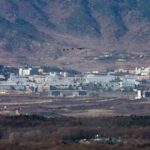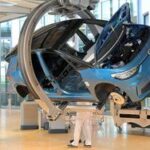
China is engaged in a power struggle with the United States in various industries and has announced astronomical support for artificial intelligence (AI). It is trying to narrow the gap. However, analysis has suggested that the gap between the two countries may deepen.
According to the South China Morning Post on the 3rd, China’s AI chip design business faces challenges due to U.S. export sanctions that restrict the export of NVIDIA’s advanced semiconductors to certain countries, including the Middle East, and intensify technological competition.
In particular, the gap between the U.S. and China is expected to widen further as NVIDIA releases new AI chips yearly.
Earlier, Jensen Huang, CEO of NVIDIA, declared on the 2nd, “We move on an annual basis,” announcing that the release of the next-generation AI chip would be shortened from two years to one.
According to research firm TrendForce, the NVIDIA Blackwell-based B100 is expected to account for about 10% of the graphics processing unit (GPU) market when shipping begins at the end of the year.
On the contrary, China’s position in the AI market is precarious due to a lack of infrastructure.
China is building a national, independent AI ecosystem to avoid U.S. sanctions. Still, industry officials have pointed out domestic production limitations, such as GPU selection restrictions, lack of access to high-performance chip manufacturing, and software shortages.
According to SCMP, rising GPU companies Biren Technology and Huawei in China are struggling with chip production as they are targets of U.S. trade sanctions.
SMIC, a foundry (semiconductor consignment production) company in China, is reportedly struggling to improve AI technology.
In particular, after several experiments, Huawei’s 910B chip has been reported to be only 60-70% of the level of NVIDIA’s previous model.
An official from H3C, a Chinese server manufacturer that experimented, stated, “Many domestically developed chips are lagging behind NVIDIA in terms of performance and stability,” and “Such technological deficiencies affect the development of large-scale AI products in China.”
On the other hand, the U.S., in collaboration with Taiwan’s TSMC, appears to be focusing on performance enhancement.
Arisa Liu, a Taiwan Economic Research Institute research fellow, said, “NVIDIA is proactively driving AI technology to meet global demand,” and “NVIDIA’s Rubin, which will be unveiled next year, will adopt TSMC technology.”
This technological gap is considered insufficient even with China’s astronomical semiconductor fund.
Earlier, on the 24th of last month, the National Integrated Circuit Industry Investment Fund, a Chinese semiconductor industry promotion fund, raised 344 billion yuan (about $47 billion) from the central government, state-owned banks, including the China Development Bank, and several companies and established the third fund on the 24th of May.
SCMP noted that China has allocated 344 billion yuan to promote national self-sufficiency. However, many industry experts have expressed concerns that the lack of a software ecosystem makes it challenging to depend solely on domestic AI production.















Most Commented